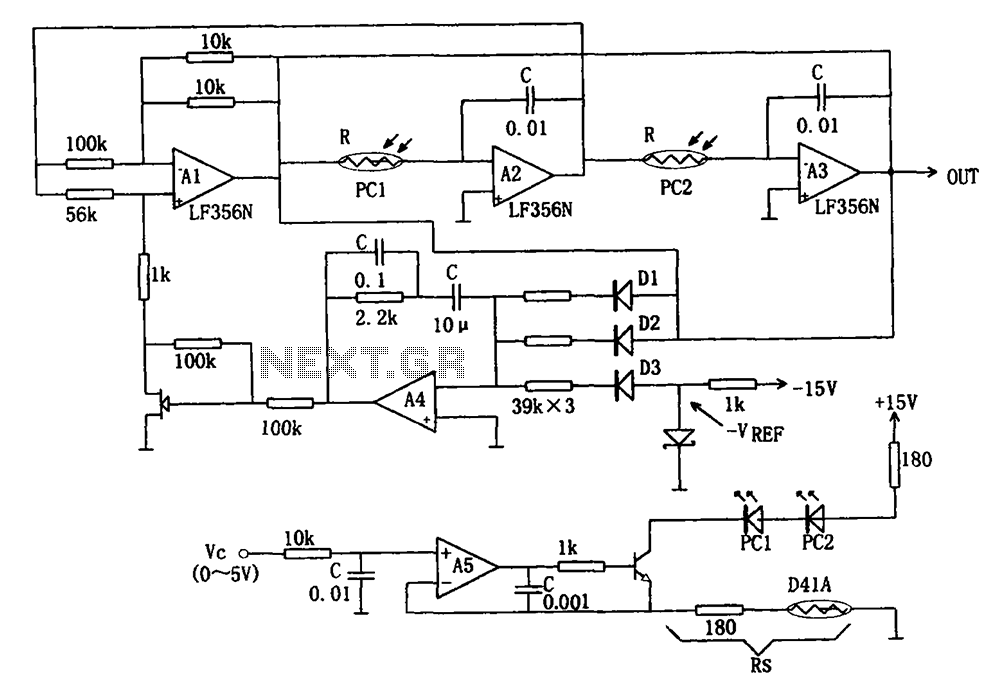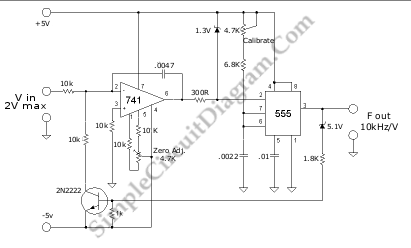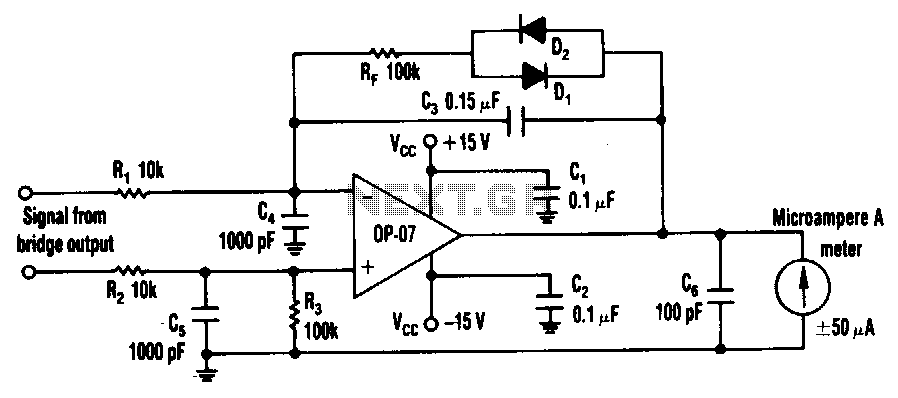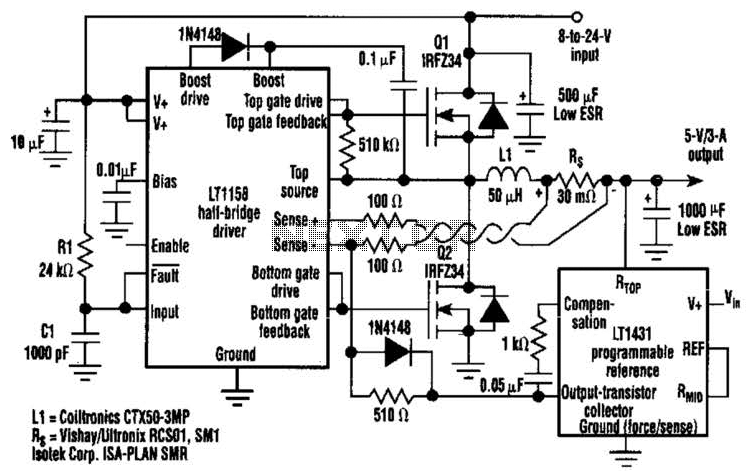
Broadband sine wave voltage controlled oscillator circuit diagram LF356N

The wideband sinusoidal voltage-controlled oscillator circuit is designed such that the oscillation frequency is determined by an integrating resistor R and a capacitor C. The voltage-controlled oscillator is constituted by the applied control voltage Vc and a control resistor R. This circuit employs variable resistors using photocouplers PC1 and PC2, along with a rectifier circuit operating in average detection mode. The circuit functions effectively at frequencies in the range of several tens of hertz. The oscillation frequency is influenced by the control voltage Vc and the characteristics of the optocoupler used. The optocoupler's light source is a light-emitting diode that requires a driving current; therefore, an op-amp circuit, specifically the 4559, is implemented to create a constant current source. The voltage-to-current conversion is achieved using a resistor Rs, which can be selected freely based on the maximum control voltage Vc. The circuit specifications indicate a maximum output current IFmax of 30mA, a maximum control voltage Vcmax of 5V, and a resistance Rs of 180 ohms.
The wideband sinusoidal voltage-controlled oscillator (VCO) circuit is a critical component in various electronic applications, particularly in communication systems and signal processing. The circuit's design relies on key components, including an integrating resistor (R) and a capacitor (C), which together define the oscillation frequency. The integration process allows for the generation of a sinusoidal waveform, making it suitable for wideband applications.
The control mechanism of the VCO is facilitated by the control voltage (Vc), which directly influences the oscillation frequency. The inclusion of variable resistors in conjunction with photocouplers (PC1 and PC2) enhances the circuit's adaptability to different operating conditions. Photocouplers provide electrical isolation and allow for control signals to modulate the VCO without direct electrical connections, improving safety and performance.
The rectifier circuit employed in the design operates in average detection mode, enabling the circuit to maintain a stable output despite variations in input signals. This characteristic is particularly advantageous when dealing with fluctuating control voltages or signal levels.
The operational amplifier (op-amp) 4559 plays a crucial role in maintaining a constant current for the light-emitting diode (LED) used in the optocoupler. This ensures that the optocoupler operates within its optimal parameters, providing reliable performance across varying conditions. The choice of resistor Rs for voltage-to-current conversion is flexible, allowing for customization based on the desired maximum control voltage (Vc) and current output (IFmax).
Overall, the wideband sinusoidal VCO circuit is a versatile and essential design, capable of delivering stable oscillation frequencies while accommodating a range of control inputs and operating conditions. Its careful selection of components and configuration ensures robust performance in various electronic applications. As shown for the wideband sinusoidal voltage controlled oscillator circuit. The circuit oscillation frequency is determined by integrating resistor R and a capacitor C, voltage -controlled oscillator is constituted by the applied voltage Vc control resistor R. Variable resistor circuit using photocoupler PC1 and PC2, rectifier circuit using the average detection mode. The actual operation of the circuit in the frequency of several tens of hertz. In addition, with respect to the control voltage Vc oscillation frequency depends on the characteristics of the circuit optocoupler used features.
Optocoupler light source is a light emitting diode driving current needs, therefore, using an op amp circuit 4559 constitute a constant current source circuit. Voltage/current conversion using Rs, the resistance Rs are free to choose the maximum control voltage Vc.
Circuit, IFmax 30mA, Vcmax 5V, the resistance Rs 180 .
The wideband sinusoidal voltage-controlled oscillator (VCO) circuit is a critical component in various electronic applications, particularly in communication systems and signal processing. The circuit's design relies on key components, including an integrating resistor (R) and a capacitor (C), which together define the oscillation frequency. The integration process allows for the generation of a sinusoidal waveform, making it suitable for wideband applications.
The control mechanism of the VCO is facilitated by the control voltage (Vc), which directly influences the oscillation frequency. The inclusion of variable resistors in conjunction with photocouplers (PC1 and PC2) enhances the circuit's adaptability to different operating conditions. Photocouplers provide electrical isolation and allow for control signals to modulate the VCO without direct electrical connections, improving safety and performance.
The rectifier circuit employed in the design operates in average detection mode, enabling the circuit to maintain a stable output despite variations in input signals. This characteristic is particularly advantageous when dealing with fluctuating control voltages or signal levels.
The operational amplifier (op-amp) 4559 plays a crucial role in maintaining a constant current for the light-emitting diode (LED) used in the optocoupler. This ensures that the optocoupler operates within its optimal parameters, providing reliable performance across varying conditions. The choice of resistor Rs for voltage-to-current conversion is flexible, allowing for customization based on the desired maximum control voltage (Vc) and current output (IFmax).
Overall, the wideband sinusoidal VCO circuit is a versatile and essential design, capable of delivering stable oscillation frequencies while accommodating a range of control inputs and operating conditions. Its careful selection of components and configuration ensures robust performance in various electronic applications. As shown for the wideband sinusoidal voltage controlled oscillator circuit. The circuit oscillation frequency is determined by integrating resistor R and a capacitor C, voltage -controlled oscillator is constituted by the applied voltage Vc control resistor R. Variable resistor circuit using photocoupler PC1 and PC2, rectifier circuit using the average detection mode. The actual operation of the circuit in the frequency of several tens of hertz. In addition, with respect to the control voltage Vc oscillation frequency depends on the characteristics of the circuit optocoupler used features.
Optocoupler light source is a light emitting diode driving current needs, therefore, using an op amp circuit 4559 constitute a constant current source circuit. Voltage/current conversion using Rs, the resistance Rs are free to choose the maximum control voltage Vc.
Circuit, IFmax 30mA, Vcmax 5V, the resistance Rs 180 .





